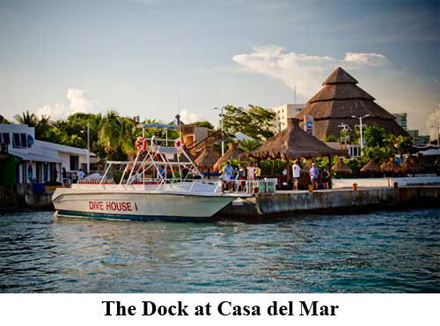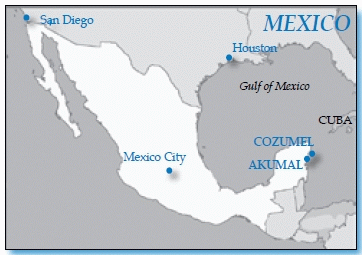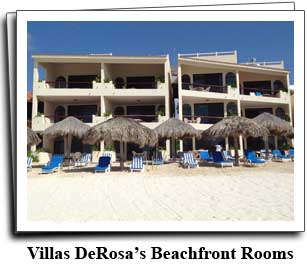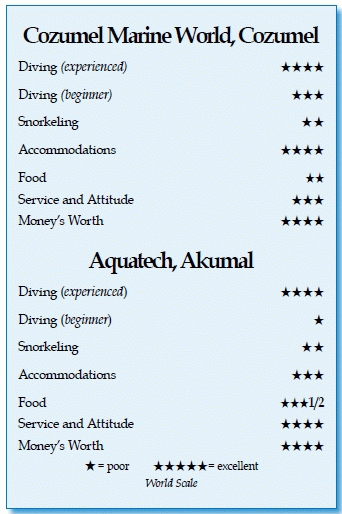Cozumel and Akumal, MexicoContents of this Issue: Let Someone Else Plan Your Dive Trip for You Damai I, Raja Ampat, Indonesia An Underwater Attack Makes World Headlines The Foolishness of Leaving Your Dive Boat Unmanned The Case for Downloading Your Dives You’re Flippant and Disrespectful, Ben Davison Editorial Office: Ben Davison Publisher and Editor Undercurrent 3020 Bridgeway, Suite 102 Sausalito, CA 94965 two unique dive trips in seven days from the June, 2014 issue of Undercurrent
Dear Fellow Diver: For more than half a century, divers have flocked to the reefs of Cozumel, so famous for drift dives along coral walls that some consider it a diving cliché. Yet most of those visitors overlook a truly unique diving experience right across on the mainland -- the freshwater cenotes of Mexico's Yucatan Peninsula. In January, I and others from my dive club joined a trip organized by my local dive shop to dive both locations in one short visit. It was like having two dive trips in one. It was one of those trips where I made no decisions at all; I didn't pick the hotel, the dive shop, my flight or even the departure day. Having made endless trips with one buddy or another where my fingers did the walking (leaving me to sweat over details, connections and dive arrangements), there's a lot to be said about joining someone else's group: just pack your gear and show up. Sure, you may not get the best of the best, but it's stress-free from beginning to end. And the price can be attractive -- for 10 nights, double-occupancy, all diving and meals, my tab was $1,814.
On our first dive, at Palancar Cave under gray skies, I was struck by the drab corals and sparse fish life. In the April 2005 issue of Undercurrent, I described a nearby site as "a glorious jumble of hard and soft corals, studded by a rainbow of sponges and faceted by grottoes, tunnels, and overhangs." This time, the corals looked like sepiatone photos of themselves, albeit under a cloudy sky. A brilliant exception was Punta Dalila, a shallower reef just north of Palancar, where we did a second dive the following day. At 59 feet, with visibility well over 80 feet, I was greeted by an eight-foot moray out prowling in the morning sunlight, keeping company with a silvery grouper. A bodacious green turtle stood on its hind flippers, munching at the underside of a coral ledge. A smaller turtle dove directly beneath me. Since Dalila is a preserve, like virtually all Cozumel dive sites, lobsters were fearless and huge. One brute had feelers the size of Alaskan king crab legs. On my safety stop, an eagle ray passed majestically below me. So, all was not lost.
Gentle currents abounded at the sites our guides chose (the two mentioned above plus Cathedral, Cedral Pass, Palancar Gardens, La Francesca, Santa Rosa Wall and Yucab). Years ago here, I had a hard time "braking" sufficiently to stay behind my dive guide. While currents normally run parallel to the shore, springtime "down drafts" have been known to push divers well past the 100- foot mark before they can adjust buoyancy and ascend. Occasionally, a diver has failed the task and disappears into the depths. I fell into a comfortable routine with diving. I was on board our boat, Maniti, by 8 a.m. each morning for two dives, then back to the resort for lunch. Afternoons were for relaxing or tinkering with dive gear. One optional night dive was offered, right off the dock, which I declined. They offered no other dives, probably due to the winds that picked up every afternoon. The 45-foot Maniti, a monohull diesel, wasn't the fastest boat in the fleet, but made smooth work of the hour-long rides to the most popular reefs. Glassy out, splashy back was the order of the day. With 42 tank wells, the boat's max capacity would be 21 divers per two-tank trip. My group was often joined by other divers with their own guide, but we never had more than 12 guests aboard. More would have turned it into a cattle boat. I noticed a DAN oxygen kit, PFDs and fire extinguishers in dry storage forward, but we had no safety briefing. The two-shelf camera table doubled as a snack buffet (cookies, sliced fruit) between dives, but at least there were separate rinse buckets for cameras and masks. We all shared a unisex marine head but there were no towels on board. Snorkelers were welcome aboard the Maniti at no extra charge, but those who tried were disappointed because the reef tops were 40 feet below them. After divemaster Paulino helped me gear up on the fantail, he jumped in first to await the other divers. We descended as a group, and when the first diver hit 700 psi, Paulino released a surface marker buoy and navigated to shallow waters, generally no deeper than 40 feet. Those with better air consumption continued exploring while the others completed their safety stops and then waited on the surface for the Maniti to find us. Sometimes the two groups got separated so one group might have a five- to 10-minute float while waiting for others to get aboard, but in calm, 80-degree water, that wasn't much of an inconvenience.
The crew of the Maniti was very friendly, even treating us to a salsa-dancing exhibition after one dive, but were a bit challenged when identifying fish. This was partially due to the language barrier, but also they just didn't always seem that knowledgeable, so I resorted to leafing through the badly-worn fish guidebook on board to identify any unique fish I had spotted. Joining a dive shop's travel group had its dividends. Silas, an employee of Marin Diving Center, served as tour guide, and was an invaluable problem-solver even though this was his first tropical dive trip. When my computer battery died, he magically produced a backup computer, which I used for the rest of the trip at no charge. That's an advantage of traveling with a dive shop; yet on the other hand, I wondered why the battery hadn't been replaced when I took it into that shop for a pre-trip tune up. Remember the old axiom: Most things that go wrong with your equipment occur right after you have it serviced.
On our last morning, we were shuttled into town to board a ferry for a 50-minute ride to Playa del Carmen, where we were to be met by vehicles from our next destination, Villas DeRosa in Akumal. But none showed, and after much too long baking on a sidewalk, one of my fellow divers had had enough and hailed a taxi for half our group. The remainder waited with Silas until he finally was able to phone the resort and arrange for a van. Acknowledging the snafu, Villas DeRosa reimbursed the cab fare. I had visited Villas DeRosa 2002, and not much has changed, even the bonerattling rutted road leading in from the highway. Villas DeRosa faces the sea, on a beach between private residences and large luxury resorts. My well-kept room, a few steps up from the pool, had white tile floors and stucco walls, a rough-hewn wood desk, two chairs and a small closet. A sunburst was painted over the twin beds that were combined into a king-width (not length) bed. One curtained window looked out on another tiny balcony. The flat-screen TV set into the wall pulled in several American channels, including commercial-free movies. After 80-degree days, nights were cool enough so I didn't need the A/C.
The entire Yucatan peninsula had once been a coral reef. The rise and fall of ocean levels over the millennia had created a series of underground caverns, complete with limestone stalagmites and stalactites, in some cases. Eventually these caverns, called cenotes, filled with gin-clear fresh water. Each day, Aquatech Dive Center, which has a small office with rental gear and locked storage at Villas DeRosa, took us by air-conditioned van to a variety of cenotes. Each was unique. At Dos Ojos, I spied a Mayan goby in the sand, and other small fish followed my light, casting oversize shadows on the limestone formations called "decorations" by locals. Halfway into the dive, my group surfaced in a dome with a small shaft of light. I could see tree roots dangling down, festooned with bats that use the light shaft to come and go at night. My dive light drove them into a flying frenzy. These were all guided dives, requiring only an openwater certification. I did swim through several dark overhead chambers, but always followed guidelines and a very competent dive leader. Most cenotes are on private property, with parking and rudimentary gift shops. Admission charges were included in our package, but at Dos Ojos, photographers were charged an extra fee, which our guides negotiated down to $20 for the group. Water temperatures were in the 70s, so I added a vest to the 3-mil wetsuit I'd been using at Cozumel. On the long walk to the sinkhole, divemaster Sergio carried my tank rig, allowing me to save my back for another day. At Jardin de Eden (which was called Ponderosa the last time I dove it), I encountered a halocline between 30 and 35 feet, where colder freshwater met saltwater seeping in from the ocean. The effect was like swimming through maple syrup, but when I felt disoriented, I cleared my head by inhaling or exhaling. We made two cenote dives a day, with a buffet lunch made from Villas DeRosa leftovers in between. Chicken and other livestock, plus emaciated dogs and ubiquitous tiny Mayan crows, provided our surface interval entertainment. A trip to the Yucatan must include at least one tour of Mayan ruins, such as nearby Tulum, preferably before diving cenotes, to grasp the history. Tulum, once a Pre-Columbian walled city, is one of the best-preserved coastal Mayan sites. These sinkholes provided the only access to fresh water for the natives, who considered them holy. (Some deep-cave divers are still recovering skulls and artifacts from sacrifices to the Mayan gods.) This spiritual nature becomes tangible when swimming through cathedral-like chambers. The eerie isolation of an overhead environment is something some people find appealing and others dread. Some passages were so tight, only one diver could pass through at a time. At Chac Mool, I encountered chambers so vast my light couldn't illuminate the walls. Unfortunately, there were dozens of other divers at this site, so strangers returning along the same line that we were following frequently interrupted my meditations. On our final dive at Chac Mool, the sun came out after four overcast days, and photographers were thrilled with the spectacle of golden "God rays" streaming down through the crystalline waters. I could almost hear the prayers of the ancient Mayans. Of course, one need not join a group to dive Cozumel or the cenotes. They certainly should be on everyone's must-do Caribbean list. And while as a foodie I can complain about the meals, I certainly can't complain about how easy it is to let someone else handle the details. -- L.C.
|

I want to get all the stories! Tell me how I can become an Undercurrent Online Member and get online access to all the articles of Undercurrent as well as thousands of first hand reports on dive operations world-wide
| Home | Online Members Area | My Account |
Login
|
Join
|
| Travel Index |
Dive Resort & Liveaboard Reviews
|
Featured Reports
|
Recent
Issues
|
Back Issues
|
|
Dive Gear
Index
|
Health/Safety Index
|
Environment & Misc.
Index
|
Seasonal Planner
|
Blogs
|
Free Articles
|
Book Picks
|
News
|
|
Special Offers
|
RSS
|
FAQ
|
About Us
|
Contact Us
|
Links
|
3020 Bridgeway, Ste 102, Sausalito, Ca 94965
All rights reserved.

 We first booked into Casa del Mar, a clean, cozy
resort about 2.5 miles south of San Miguel de Cozumel,
the island's main
town. The resort,
with 98 rooms plus
eight cabanas, is
located on the
inland side of the
Malecon, from which
I took a footbridge
over the busy thoroughfare
to access a
pier with three different
dive operators.
I and eight
others from my dive club had been pre-assigned to
Cozumel Marine World, which provided
good, attentive service through
four days of diving.
We first booked into Casa del Mar, a clean, cozy
resort about 2.5 miles south of San Miguel de Cozumel,
the island's main
town. The resort,
with 98 rooms plus
eight cabanas, is
located on the
inland side of the
Malecon, from which
I took a footbridge
over the busy thoroughfare
to access a
pier with three different
dive operators.
I and eight
others from my dive club had been pre-assigned to
Cozumel Marine World, which provided
good, attentive service through
four days of diving. They split us into two groups: photographers and non-photographers. This
worked for a couple of days, but the cinematographers found themselves crowding
up and competing for close-up shots, and soon the groups were re-arranged. But I
learned a valuable lesson: Reef colors still pop under strobes and bright flashlights,
so I would suggest carrying a dive light even on day dives. Besides,
we navigated a bunch of intriguing tunnels and swim-throughs where those with
lights were able to spot reclusive critters (like the splendid toadfish) in the
cracks and crevices.
They split us into two groups: photographers and non-photographers. This
worked for a couple of days, but the cinematographers found themselves crowding
up and competing for close-up shots, and soon the groups were re-arranged. But I
learned a valuable lesson: Reef colors still pop under strobes and bright flashlights,
so I would suggest carrying a dive light even on day dives. Besides,
we navigated a bunch of intriguing tunnels and swim-throughs where those with
lights were able to spot reclusive critters (like the splendid toadfish) in the
cracks and crevices. My deluxe room had two double beds, a TV with almost all Spanish channels,
and a dark closet with a safe. Every day the maid folded my fresh towels in the
shape of different animals -- a nice artsy touch. A postage-stamp-sized balcony
with bench was just big enough for drying dive gear. Casa del Mar is an all-inclusive
resort, which has its plusses and minuses. Our group, which started as
two separate cliques, soon bonded over meals and cocktails. It also made life
easier for Silas to keep us all herded together. However, the food at the Palapa
restaurant was crashingly mediocre, pretty much the worst of Mexican and American
cuisine. Can you believe no hot sauce? One of my buddies had to venture out to a
convenience store to bring in a bottle. The most authentic thing about the restaurant
was the incomprehensible accents of the waiters. By the time I left,
I had tried most of the selections on the menu, and was ready for a change.
Similarly, the bar had a very limited selection (no Scotch, for instance), and
mixed drinks were weak. In retrospect, we should have tried more local restaurants.
But travelers with packages get hung up when they prepay. "Damn, I already
paid for that thing, so I'm gonna eat it." One night, a couple of us ventured
into town for a fresh shrimp dinner, which was well worth the extra $20.
My deluxe room had two double beds, a TV with almost all Spanish channels,
and a dark closet with a safe. Every day the maid folded my fresh towels in the
shape of different animals -- a nice artsy touch. A postage-stamp-sized balcony
with bench was just big enough for drying dive gear. Casa del Mar is an all-inclusive
resort, which has its plusses and minuses. Our group, which started as
two separate cliques, soon bonded over meals and cocktails. It also made life
easier for Silas to keep us all herded together. However, the food at the Palapa
restaurant was crashingly mediocre, pretty much the worst of Mexican and American
cuisine. Can you believe no hot sauce? One of my buddies had to venture out to a
convenience store to bring in a bottle. The most authentic thing about the restaurant
was the incomprehensible accents of the waiters. By the time I left,
I had tried most of the selections on the menu, and was ready for a change.
Similarly, the bar had a very limited selection (no Scotch, for instance), and
mixed drinks were weak. In retrospect, we should have tried more local restaurants.
But travelers with packages get hung up when they prepay. "Damn, I already
paid for that thing, so I'm gonna eat it." One night, a couple of us ventured
into town for a fresh shrimp dinner, which was well worth the extra $20. This remote beachfront resort
also offers American-plan dining -- a
necessity because there are no other
restaurants or stores in the vicinity.
The difference from Casa del Mar
was that Villas DeRosa has no menu.
Breakfast, lunch and dinner are all
chef's choice, served family style,
with a few concessions to those with
dietary restrictions. Lunches featured
extra crispy fried grouper, tortilla
soup, chili rellenos or a burger.
At dinner, we shared fajitas, chili
rellenos, or rolled chicken breasts
with savory glaze, rice and veggies.
Everyone enjoyed the soups, potato
cheese and puréed broccoli especially,
but the group favorite was pulled
mystery meat in a mystery sauce.
Unrecognizable, but tasty. The meals
were zestier than at Casa del Mar,
but having no options, it got old
quickly. There is a very cute Bikini
Beach Bar on the sand, but they
wouldn't charge drinks to our rooms
and insisted on cash, so most of us
took a 10-minute cab ride into tiny
Akumal to stock up on necessities. I
don't know why the bar would maintain
such a self-defeating policy.
This remote beachfront resort
also offers American-plan dining -- a
necessity because there are no other
restaurants or stores in the vicinity.
The difference from Casa del Mar
was that Villas DeRosa has no menu.
Breakfast, lunch and dinner are all
chef's choice, served family style,
with a few concessions to those with
dietary restrictions. Lunches featured
extra crispy fried grouper, tortilla
soup, chili rellenos or a burger.
At dinner, we shared fajitas, chili
rellenos, or rolled chicken breasts
with savory glaze, rice and veggies.
Everyone enjoyed the soups, potato
cheese and puréed broccoli especially,
but the group favorite was pulled
mystery meat in a mystery sauce.
Unrecognizable, but tasty. The meals
were zestier than at Casa del Mar,
but having no options, it got old
quickly. There is a very cute Bikini
Beach Bar on the sand, but they
wouldn't charge drinks to our rooms
and insisted on cash, so most of us
took a 10-minute cab ride into tiny
Akumal to stock up on necessities. I
don't know why the bar would maintain
such a self-defeating policy. Divers Compass: My trip was put together by Marin Diving Center
of San Rafael, CA, using the wholesaler Caradonna Dive Adventures;
my package, including 10 days of accommodations, meals, diving,
transfers, ferry, taxes and service charges, cost $1,814 . . . I
needed Mexican pesos to prepay the Marine Park fee ($2.50 per day)
and a $15 fuel surcharge for the long ride to Cathedral at Punta
Sur Reef . . . Cozumel has a number of recompression chambers
(local divemasters are infamous for getting bent after too many
repetitive dive days) and the newest is the Costamed Hyberbaric
Center, a DAN-preferred provider (
Divers Compass: My trip was put together by Marin Diving Center
of San Rafael, CA, using the wholesaler Caradonna Dive Adventures;
my package, including 10 days of accommodations, meals, diving,
transfers, ferry, taxes and service charges, cost $1,814 . . . I
needed Mexican pesos to prepay the Marine Park fee ($2.50 per day)
and a $15 fuel surcharge for the long ride to Cathedral at Punta
Sur Reef . . . Cozumel has a number of recompression chambers
(local divemasters are infamous for getting bent after too many
repetitive dive days) and the newest is the Costamed Hyberbaric
Center, a DAN-preferred provider ( 